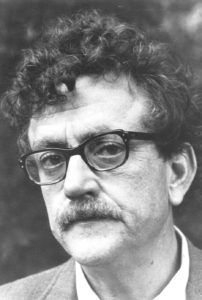
Recently I picked up Conversations with Kurt Vonnegut, part of the Literary Conversations Series from University Press of Mississippi. The collection offers interviews and profiles of Vonnegut published between 1969 and 1999. The first comes shortly after the publication of Slaughterhouse-Five. The subsequent rocket ride of literary stardom Vonnegut enjoyed—or endured—follows.
The collection seems rather complete, culling all manner of sources, right down to a softball Q&A with Harry Reasoner for 60 Minutes. The collection is breezy if thought-provoking reading, much like many of Vonnegut’s books, but it still held a few surprises for me. (Apparently after the success of Slaughterhouse-Five, Vonnegut contemplated throwing out Breakfast of Champions when he realized he could now sell any book he wrote no matter its quality.)
The more I learn about Vonnegut, the more I’ve come to see how pragmatic he was when it came to the craft of writing. Vonnegut often lists Robert Louis Stevenson as one of his favorite authors because, as a boy, he was “excited by stories which were well-made. Real ‘story’ stories…with a beginning, middle, and end.” His essay “How to Write With Style” is advice of the roll-up-your-sleeves variety, featuring watery chestnuts like “Find a subject you care about” and “Keep it simple.” More interestingly, while teaching at the Iowa Writers’ Workshop, he led a course to help students make a career out of writing after graduating—teaching, technical writing, ad copy, anything to put bread on the table. Apparently the course was not well-regarded by the other faculty.
One popular meme is Vonnegut’s lecture on the shape of stories. The audience chortles as he chalks out curves and lines graphing a set of basic story structures. (Maya Eliam’s infographics of these shapes are lucid and wonderful.) Most likely many in the auditorium thought he was satirizing when he said story forms could be graphed mathematically or analyzed by a computer, but his lecture is in earnest. This was his master’s thesis in anthropology, after all.
In a 1977 interview with Paris Review—the most in-depth interview in the collection—Vonnegut drops a mention of his story shapes:
Vonnegut: Somebody gets into trouble, and then gets out again; somebody loses something and gets it back; somebody is wronged and gets revenge; Cinderella; somebody hits the skids and just goes down, down, down; people fall in love with each other, and a lot of other people get in the way…
Interviewer: If you will pardon my saying so, these are very old-fashioned plots.
Vonnegut: I guarantee you that no modern story scheme, even plotlessness, will give a reader genuine satisfaction, unless one of those old fashioned plots is smuggled in somewhere. I don’t praise plots as accurate representations of life, but as ways to keep readers reading. … When you exclude plot, when you exclude anyone’s wanting anything, you exclude the reader, which is a mean-spirited thing to do.
The last sentence may be the most plainly spoken argument against the avant-garde I’ve read.
Vonnegut even compared writing novels to experiments, which I’ve explored myself. He felt experimentation was in his nature due to his education as a chemist and an engineer. (I believe this is the first time I’ve read another fiction writer describe creating fiction as a kind of experiment.) Here he talks with Laurie Clancy about Breakfast of Champions (still unpublished at this point):
Interviewer: Could you indicate what direction your new work is taking?
Vonnegut: It’s in the nature of an experiment. I don’t know how it’s going to come out or what the meaning’s going to be—but I’ve set up a situation where there’s only one person in the whole universe who has free will, who has to decide what to do next and why, has to wonder what’s really going on and what he’s supposed to do. … What the implications of this are I don’t know but I’m running off the experiment now. I’ll somehow have a conclusion when I’ve worked long enough on the book. … Regarding [God Bless You, Mr. Rosewater], I said to myself “Well, all right, what happens when you give poor people money?” So I ran the experiment off and tried to control it as responsibly as I could.
The Clancy interview is one of the best in the book. Vonnegut is engaged, thoughtful, and revelatory.